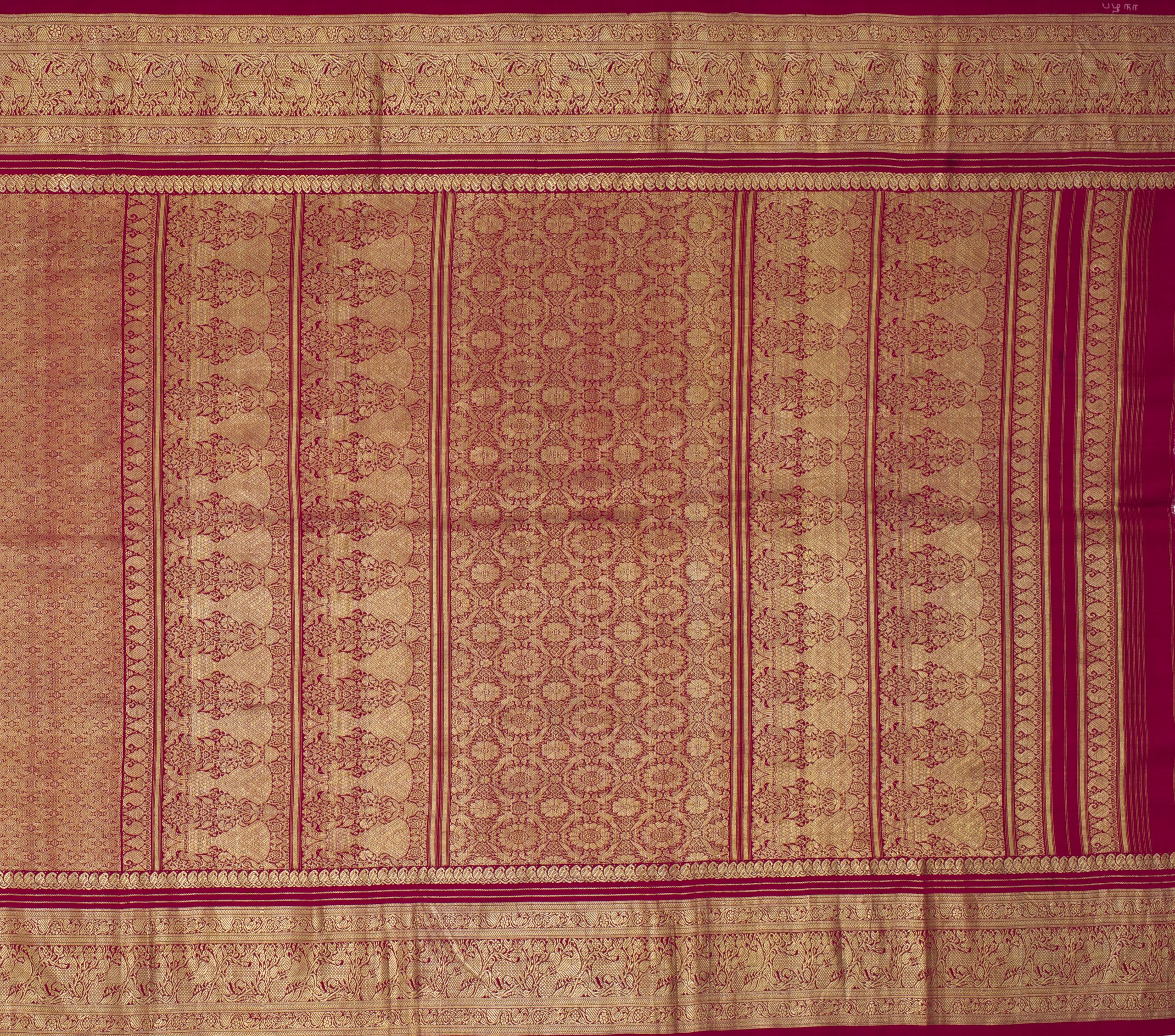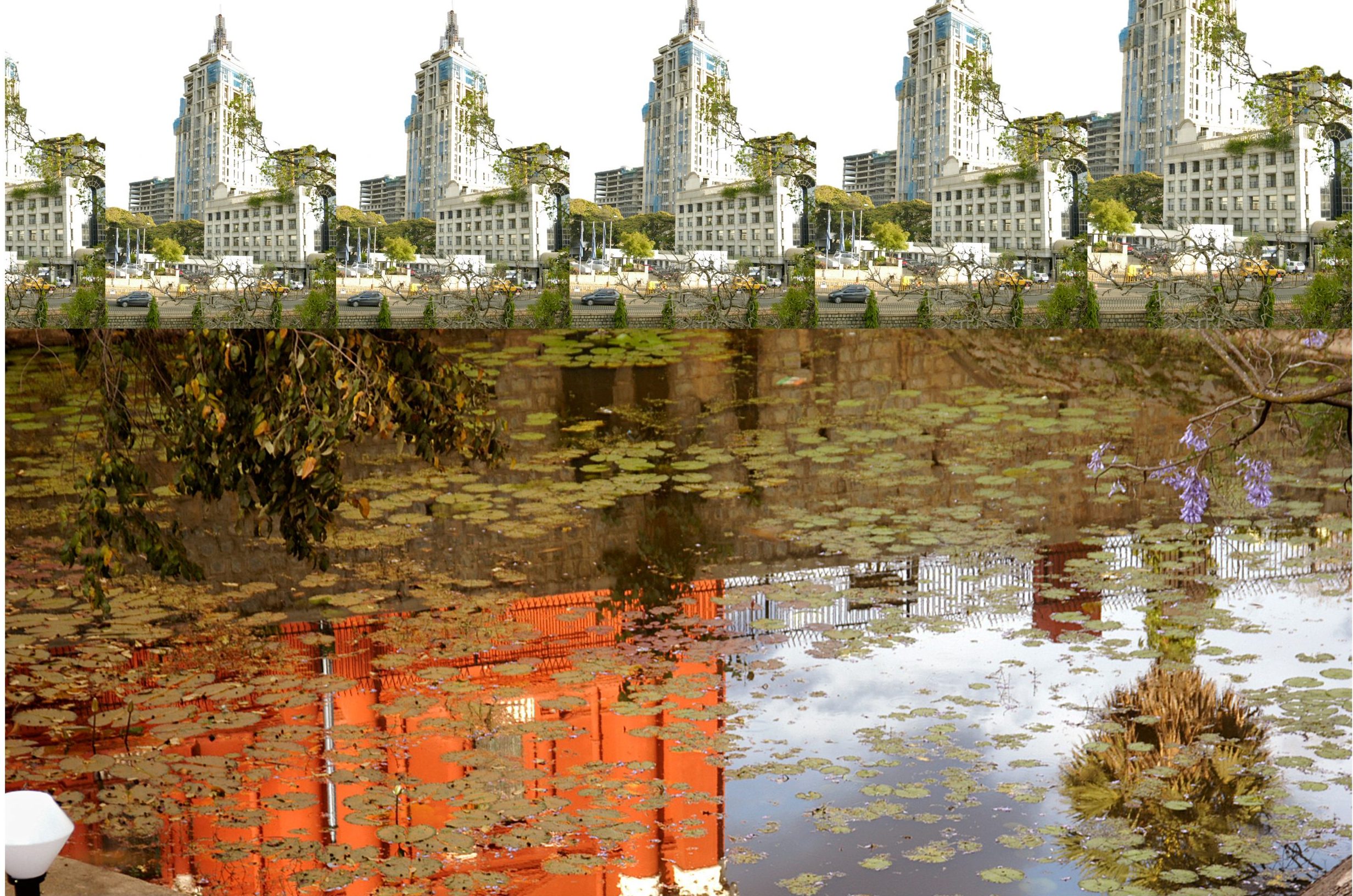Interviews
From Writing to Seeing and Back
Arshad Hakim, Vaishnavi Kambadur & Samira Bose
Arshad Hakim, Vaishnavi Kambadur, and Samira Bose discuss their curatorial collaboration between a museum and an archive for MAP’s latest exhibition on K. G. Subramanyan’s artworks and writings.
This conversation between co-curators Arshad Hakim, Vaishnavi Kambadur (MAP) and Samira Bose (AAA in India) is an extension of the online exhibition Bahurupee in the Panorama: Writing and Artwork of K. G. Subramanyan. Here, they discuss the process and methods behind the exhibition, and the collaboration between a museum and an archive. The conversation has been edited and condensed for clarity. It was first published in AAA’s online journal, IDEAS.
On Subramanyan as an Educator and Writer
Arshad Hakim (AH): To begin, I’ll go with what is most evident: We know that K. G. Subramanyan as a figure is extremely important within the subcontinent and a lot of work has already been done on him, in terms of his writings, his practice, and his pedagogy. What were your impulses to work with Subramanyan’s artworks and his archive, and how do you see this collaboration between two institutions adding to the already existing discourse on Subramanyan?
Vaishnavi Kambadur (VK): When we were brainstorming amongst the team about how to conceptualise the exhibition, I remember going on Asia Art Archive’s website and seeing so many archives of artists like Nilima Sheikh, Jyoti Bhatt, and Ratan Parimoo—and Subramanyan’s artworks in MAP’s collection had a lot of connections with them. From the 1960s to 2000s, and across mediums like terracotta and gouache on paper, the artworks covered many aspects of Subramanyan’s work.
Having said that, we wanted to look at something that was different from the pre-existing pedagogy and maybe the hope was to produce something that wasn’t done before in an online space. In a sense, we wanted the museum collection and artist’s archive to inform each other and co-exist in this exhibition.
Samira Bose (SB): Yes, we’re familiar with his work more through large-scale retrospectives and monographs, or his monumental murals in public spaces—all of which are great to experience! However, we wanted to approach Subramanyan less through the lineage of a “master artist,” and more as a pedagogue, since art education was such a major part of his life. We also wanted to learn how he spoke of his practice, his reflections over the years, his “visions.”
The initial impetus for this was to really jump into his writing, and to take the ideas therein as starting points to approach his work. Both Vaishnavi and I, sitting in Bangalore and Delhi, without any sort of direct connections to the artist or the Faculty of Fine Arts, MS University of Baroda, took deep dives into a wide range of his writings (from 1960 to as recently as 2012).
As we made our way through his texts, we started noticing connections and patterns. We read them as “keywords,” but these were clearly conceptual cores of sorts for his practice over time, and we were drawn to this sense of recall from his childhood—how he regarded the more formative times of his life and how his encounters then formed his entire approach to art and art-making.
A key term we began to notice was “panorama.” I encountered it first in an introductory talk he gave at a seminar titled “Art and Craft Panorama in India” at the Museum of Modern Art, Oxford, in 1998. I think it was a bit of a jab at the Global North/Western audience in terms of how they might regard the art scene in India through a lens of paucity, or in limited terms, whereas he said that in a “rich” place like India, you just have to look around you to witness an intense and connected art scene, with figures playing all kinds of roles. He says there’s art in the home, in the streets, in workshops, in religious gathering places, or improvised in shops. For example, apart from daily artistic practices carried out at home by women, such as weaving, threshold paintings, ritual clay modelling, etc., there’s also carpenters able to make intricate sculptures from wood, or brass-founders able to conjure large figurines.
He describes a lively and highly “stimulating” panorama, and every time I would read the term in his writing, I felt I could see this through a sort of virtual lens (thinking for some reason through my phone camera), and it’s this scene where things are not neatly categorised, where humans and non-humans are mixing. Vaishnavi was especially attuned to his viewpoint on craft, based on her background and training.
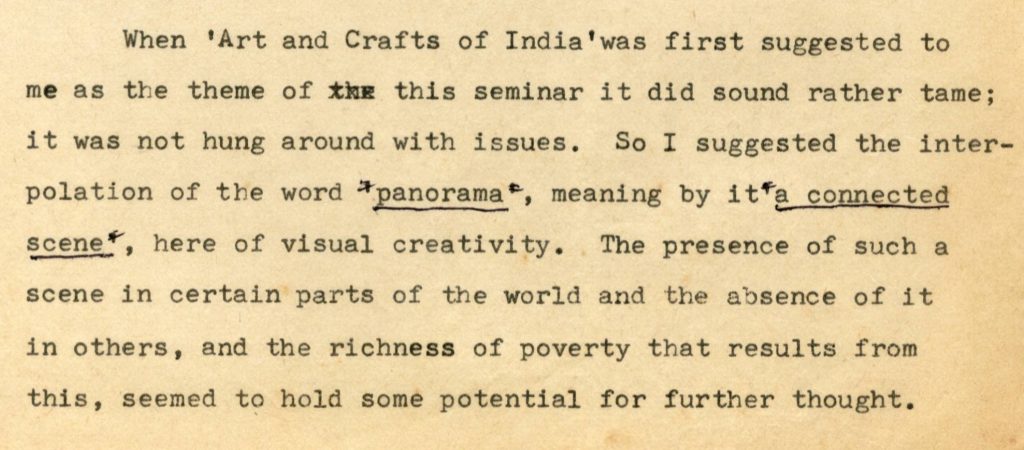
Excerpt from the Introductory talk at the Seminar ‘Art and Craft Panorama in India’ (at the Museum of Modern Art, Oxford), 1998, Courtesy of K. G. Subramanyan Archive, Asia Art Archive Collections
VK: Samira and I were looking at the same writings and interpreted them differently. The craft aspect and how Subramanyan goes into these imaginary excursions and storytelling stood out to me. I come from a fashion and textile academia background and didn’t encounter Subramanyan’s work as a student. I knew that many modern visual artists contributed to the formation of the All India Handloom Board, and through this curatorial experience, I discovered aspects of how Subramanyan (who was part of the board in the 1960s) was concerned about handmade textiles. His thoughts on the theme “Arts and Crafts of India” centred around craft being absorbed in everyday life, and this also transferred to his murals and teaching methodology in Baroda.
His writing went into questions like: “How does a girl in northern Gujarat paint the same motifs on walls and embroider them on textiles? How do these interconnected scenes play a major role in his own life?” For instance, in describing his panorama, he recalled that his mother “commanded many skills, she was adept at weaving mats, making baskets and toys from coconut fronds, laying and burnishing lime plaster floors…”
On Mind Maps and Subramanyan’s Writing
AH: You mention that Subramanyan’s writing became a fulcrum through which the entire exhibition is thought through. I see a dichotomy here and I want to point that out: we know that text particularly works in a very semantic manner, whereas if we look at Subramanyan’s work, it is the complete antithesis of a semantic order, or a very different configuration of a semantic order. And yet, at the same time, we know that he’s written extensively on the things that he’s interested in. How did that play out conceptually: as a method of working in a highly semantic order and thinking through something that is the antithesis of it?
VK: Creating a mind map really helped us think about Subramanyan’s work and the language around it. Arnika from our team was working on an archival project in December last year and had suggested the idea of connecting keywords, visuals, and manuscripts of Subramanyan. This was a great suggestion, and I immediately attempted to execute this on software called Miro Board. We had to move around artworks and key excerpts while working on the first few drafts because we wanted people to approach the design of the exhibition from any point and still take something away. Samira had already selected some excerpts, and the curiosity to link Subramanyan’s artworks in relation to them and each other kept evolving. Even thinking about the design of the digital exhibition as a panorama and placing everything next to each other or around each other in this non-linear narrative was really important to our curatorial process.
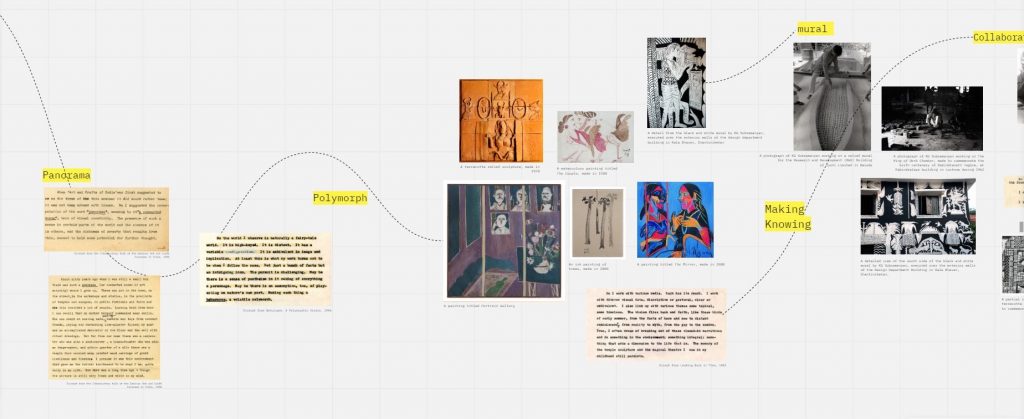
Screenshot from the work-in-progress for Baharupee in The Panorama on Miro Board.
SB: Absolutely, as Vaishnavi says, non-linear was key because while there was some sort of order to the way we were going through his texts, and considering the archive is quite organised, Subramanyan’s practice and orientation to materials and methods is anything but linear. He would engage forms over several decades in myriad ways, and he would just as easily try out and take on making toys or weaving as he would modernist abstraction in painting. There’s a certain openness, a lightness, with which he would move from one form to another, much like his roving eyes in the panorama. And so we felt the necessity, exactly as you’re asking about semantics, to transition from thinking through his texts to a more visual and engaged form such as the Miro Board. The format also allows us to try (what feels like infinite) compositions and permutations—and so we began our meandering there, visualising what we had read, by now by turning to documentation of his work. Text would lead to image, which would lead to text, which would maybe lead to a long Post-it note on our own responses.
The Miro Board allows various compositions and for us to locate our meandering, to visualise what we had been reading. It was also an interesting way for us to “read” or keep track of the ways we were working with these materials, however distant geographically, and the different aspects that stood out to us.
On that note, Arshad, perhaps you could share a bit about your interest in the “bahurupee” figure in his writing, and how that led to one of the conceptual frameworks within the exhibition.
On the figure of the Bahurupee: Volatility, Playfulness, and Ambivalence
AH: During my meanderings within the archive, I came across this text titled “Bahurupee: A Polymorphic Vision,” which he wrote for a catalogue for his show at the Centre of International Modern Art (CIMA), Kolkata, in 1994. Within the text, there is a constant back-and-forth that happens between his sense of interiority, and his sense of what is out there in the world. And for Subramanyan, again, that is very blurred. And then he comes to this term “bahurupee,” which he says is a volatile polymorph—it is a mixing of the worldly with the un-worldly and the other-worldly, and it is also a mixing of fact with fantasy. He then goes on to say that it is an unstable configuration. After I read that, I could only look at Subramanyan’s work through this lens.
Given that we were working with the framework of the panorama, which is a slightly overarching framework, where the panorama is a zoomed-out scene, I felt the need to really unsettle this and make it more volatile. The impulse, then, became to see what a “zoomed-in” scene within the panorama would look like.
The figure of the bahurupee made sense because when you zoom into this panorama, you see that things are constantly shifting. Even though it is a connected scene, it is an unstable scene—the configuration is always shifting and is variable. This is where and when the figure of the bahurupee came into play.
A line from this catalogue text intrigued me, and I quote: “The growth of an untrammelled vision. Ecstatic eyes, peering out of an emaciated body.” He then goes on within the text, to reference the miniature of Inayat Khan on his deathbed. The imagination that death as a limit would lead to an untrammelled vision seemed to make sense in some weird way. The retrospective outlook for me resonated with Walter Benjamin’s reading of Paul Klee’s Angelus Novus: the angel looking back at the wreckage of history, and here’s Subramanyan looking back at the world as a configuration to play with.
Perhaps this might be another way to look and read Subramanyan, and he writes this within the essay: “[I]t’s a fairly-tale world, it is high-keyed and it is distant. The image, has an ambivalent implication.” The figure of the bahurupee is situated within playfulness and ambivalence.
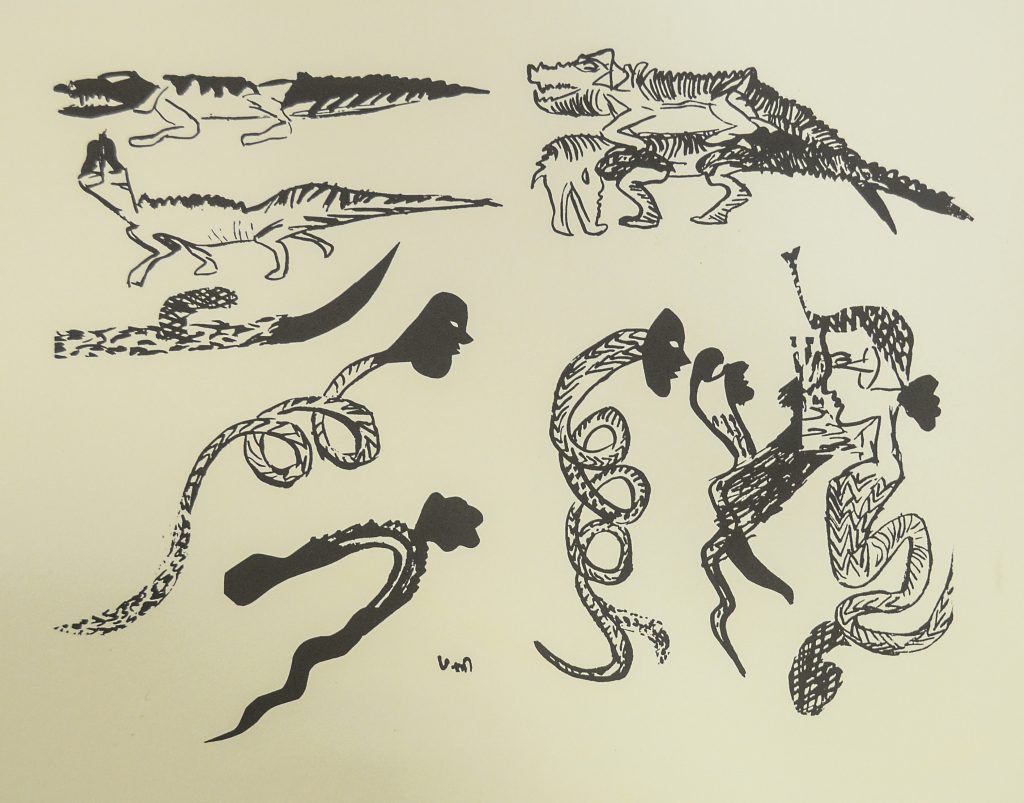
Untitled by K.G. Subramanyan, Screen Print on Paper (Serigraph), MAC.00785
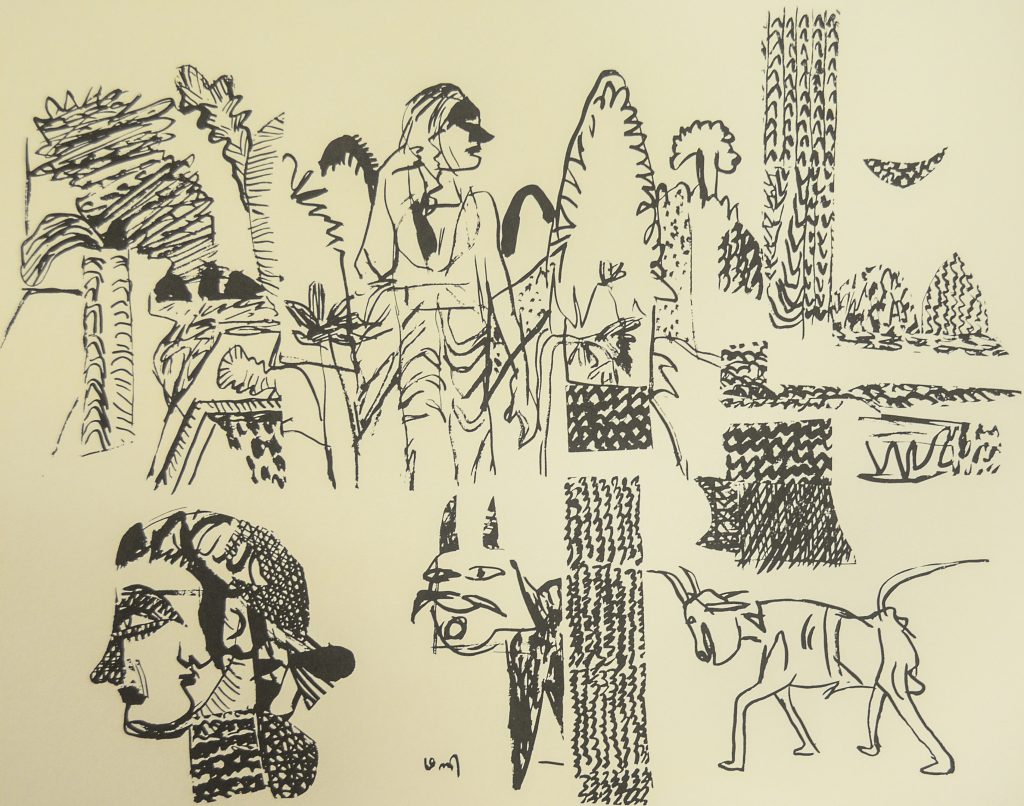
Untitled by K.G. Subramanyan, Screen Print on Paper (Serigraph), MAC.00786
VK: I have an anecdote to share: when we were working on image descriptions and alt-text for accessibility recently, we closely looked at images of artworks. I remember that I was looking at the terracotta sculpture in MAP’s collection depicting a human figure with cows or bulls around it. Arshad had written the image description as “a square terracotta mural, divided into nine equal registers showing a woman at the centre bottom and cows” and with alt-text, you have to be more descriptive so I magnified the image and noticed that the cows or bulls were wearing clothes. The top-most one had a hint of a shirt collar and folds. I asked Arshad, “What are these figures? Are they animals or humans?” And along with bahurupee or polymorph, these observations tied it with other terms that we explored like animal-human hybrids and the mirroring of figures.

Woman with Cows by K. G. Subramanyan, c. 1970, Terracotta, H. 52 cm x W. 50 cm, MAC.01146
SB: A panorama could also serve surveillance purposes, whether we think of the sweeping glare of the guard in a prison panopticon or the gaze of the CCTV on unsuspecting citizens, but the way Subramanyan speaks about it is so much more about observing the entanglement of environments and infrastructures—the potential magic of daily life, in a sense.
AH: Responding to your prompt, within his writings, one realises that Subramanyan looks at art or sees the artwork as an oracular force, where each artwork opens up a passage that moves both ways, moves in both directions—it moves inwards and outwards, simultaneously. It made sense to me that his work follows this direction and that we should follow this in the exhibition.
On Material Dexterity, Tooling, and Institution Building
VK: Arshad, since you studied at the Faculty of Fine Arts in Baroda, could you tell us if you were surrounded by Subramanyan’s teachings and works?
AH: Some of his murals and even some of his paintings are spread across the campus of the Faculty of Fine Arts, and we would see it every day. I remember the first time I saw it, I was in awe with the scale and how the surface was treated—I remember feeling that the surface could move at any instant and the forms looked alien. All this was contained within a frame, which to me also spoke about how powerful one’s imagination can be.
As an effect of Subramanyan as an institution builder and pedagogue, he passed down the importance of knowing what material one is working with, on knowing material dexterity. We use the word “tooling” within the exhibition as a keyword, and for those of us who studied in Baroda, this was one of the first things we were told in our classes—one needs to really know what tools one is working with. Subramanyan passed this down to his students, who were teachers to my teachers, and they passed it down to me. The other gift he passed down was to be intuitive with your surroundings and to know your materials, to clearly recognise your intuition and trust it.

Untitled by K. G. Subramanyan, 2007, Charcoal and gouache on paper, H. 37 cm x W.28 cm, MAC.01895
SB: I found the idea of “making and knowing” to be an important facet within his work and propositions, because he alludes a lot to different kinds of knowledges, embodied and discursive, and that these should be regarded and considered in equal measure. “Making” can be a thinking process, and I’m quoting Ursula Le Guin here but “words can do.” Perhaps his relation to text and his storytelling style, where he conjures entire worlds from his childhood and his intensive writing practice alongside his other work, signifies that he doesn’t see these processes as categorically separate. And there are liberties that art provides to be able to move between these knowledges and methods.
But, actually, I want to go back to his reference to museums as “catacombs.”
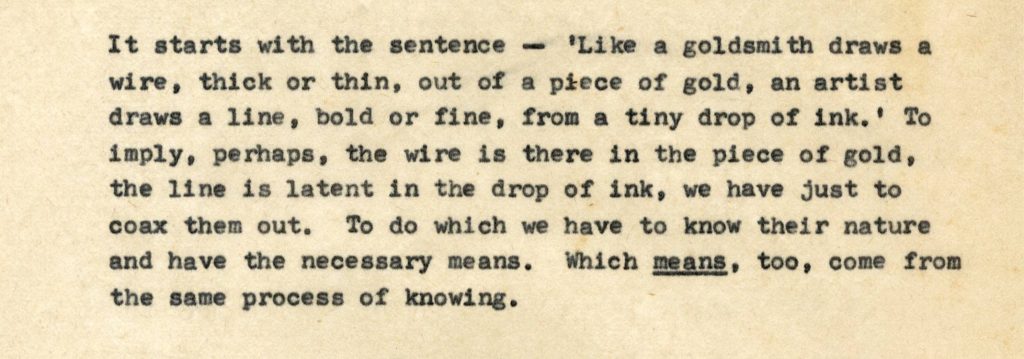
Excerpt from The Magic of Making 1989, Courtesy of K. G. Subramanyan Archive, Asia Art Archive Collections
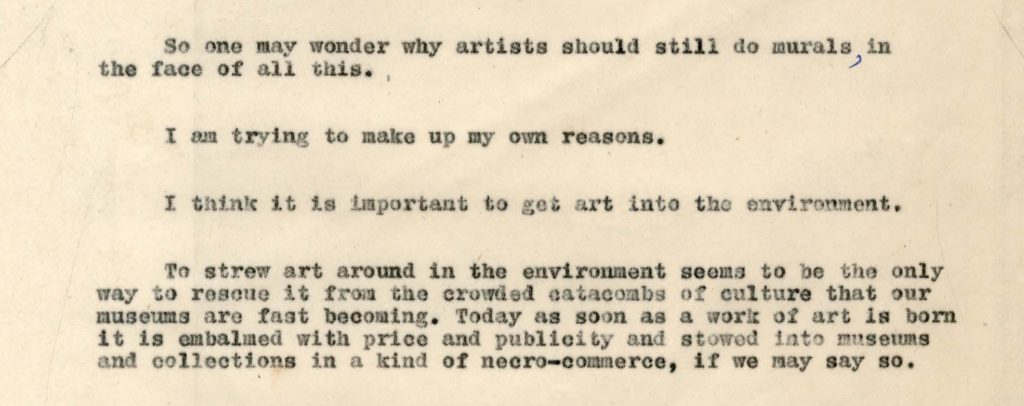
Excerpt from Some Notes on Mural, 1972, Courtesy of K. G. Subramanyan Archive, Asia Art Archive Collections
On Murals, Non-linearity, and World-building
VK: I think he references museums as “crowded catacombs of culture” in reference to a specific time period (1972), and the context of museums was very different back then. The fact that we are collaborating right now, and that we are using artworks in such a non-linear sense—it was an unlearning experience, because we tend to go from the earliest artwork in the collection to the most recent one and create a timeline. Obviously, with Subramanyan’s work we see that every artwork has multiple stories within it.
With murals specifically, the idea was that we can’t transport a mural from the 1960s in a site-exhibition right now, and so the archive was a way to facilitate that viewing of murals in an online exhibition using a graphic experience. When Arshad entered this exhibition after Samira and I had conceptualised some of it, and when we were showing him one of the first drafts of our mind map, he asked something like, “How would Subramanyan imagine the curation of this exhibition? How would he view these artworks?” That’s such a different way to think about displaying a museum collection.
SB: I’ve been fascinated by how dramatic the photo-documentation of these murals are, playing with light and shadow, and I have speculated elsewhere that these can serve as more than mere documents of a physical object, but have a life and affective charge of their own. Several were taken by Jyoti Bhatt, but even where we don’t know the author, there is an intentionality in the framing and photographic rendering. The mural becomes an image.
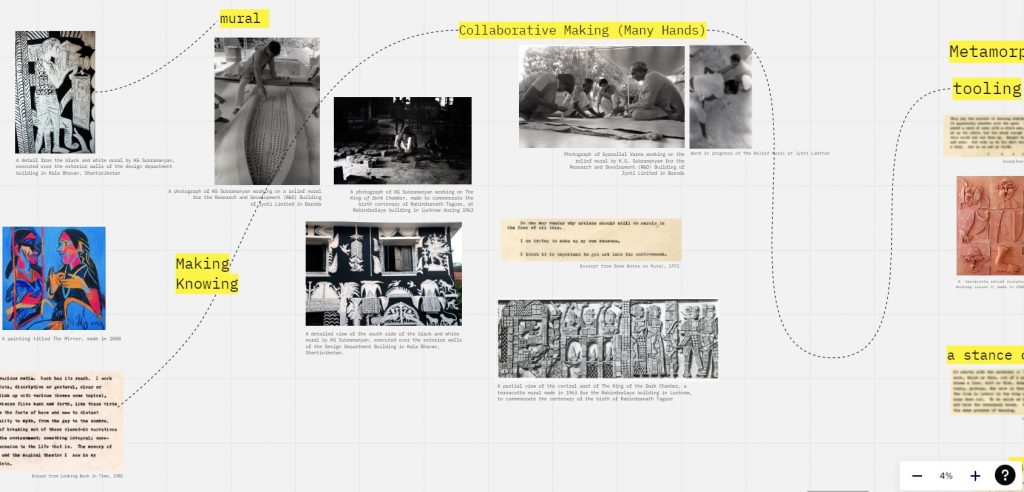
Screenshot from the work-in-progress for Baharupee in The Panorama on Miro Board.
VK: The last part of the panorama includes Subramanyan’s compositions of nature and how he discovers and doodles them. We had looked at specific animals that Subramanyan was referencing, such as stories of stone monkeys or the story about the caterpillar’s life cycle that takes on human forms much later in his drawings.
In a way, the panorama is also experiencing a life cycle, it is shedding its human form and coming back to its natural form. We are seeing nature in its element in a direct way with his ink drawings. To be able to capture this in the loop of the panorama was important.

Untitled by K.G. Subramanyan, c. 1970, Watercolour on paper, H. 9.5 cm x W. 14.5 cm, MAC.01380
Arshad and Samira, could you share your thoughts on discovering, doodling, and nature?
SB: We come to the animals and nature towards the end of the panorama (even though it’s a starting point in a panoramic loop) because several of them are rendered as part of his doodles and sketches, and one of the threads we tried to follow was how he talks about movement in his surroundings and capturing them—and art practices able to hold this movement. There is a very eloquent essay in Gulammohammed Sheikh’s archive that he wrote together with Nilima Sheikh, a catalogue essay related to the K. G. Subramanyan – Retrospective Exhibition from 1981-82 in Madhya Pradesh.
A side note is that we arrived at this essay months after we had been working on the exhibition but towards the end it became formative for us and our articulation of how we feel affected by Subramanyan’s ideas and practice today. In any case, I’m referring to this because they talk about how “every lover of art knows that the real nature of artists’ sensitivities lies in his working drawings rather than his finished products,” and while the doodles and sketches are not from his private notebooks and are in fact finished works, there’s an animated energy to them and how Subramanyan looks at movement in his surroundings that we wanted to conclude with.
There’s another part of this essay that resonated so much with what we have been thinking about in terms of a “sense of wonder” that underlies Subramanyan’s practice, and the way he draws on the “daily drama” of his surroundings. The everyday is infused, through the artist’s lens, with a sense of magic and fantasy. And this brings us back to the polymorphic in the panorama.
AH: Especially with some of the works within this exhibition, we see an animal becoming a human, a human becoming a tool, a tool becoming something else. A woman turning into a goddess, and the reverse. We constantly see these configurations that feel like they are yet-to-become, or snapshots of a becoming that is occurring, a snapshot taken at an in-transition point—and the imagery is built on that. We also realise that the constant oscillation between what is a fact and what is fantasy is completely undone. An entire world is built around this oscillation and this unstable configuration, where shape-shifting becomes very important, and mixing the other-worldly with the mundane becomes essential.
This is where I came to the idea that perhaps, now, we could also look at Subramanyan’s practice as a world-building practice—his practice incorporates myths, responds to sociopolitical surroundings, and builds a world with and around them. It also resonates with the idea that he was an institutional builder and a pedagogue, so he is also building worlds within the institutions he functions and with his students, while letting them into his world, too—a world that extends beyond the given frame and takes a life of its own. A world that isn’t insular but is receptive to its surroundings and lets everything in.
Arshad Hakim is an artist and filmmaker and is currently the Programmes Coordinator at the Museum of Art & Photography, Bengaluru.
Samira Bose is Programmes Coordinator at AAA in India.
Vaishnavi Kambadur is the Assistant Curator at the Museum of Art & Photography, Bengaluru.

